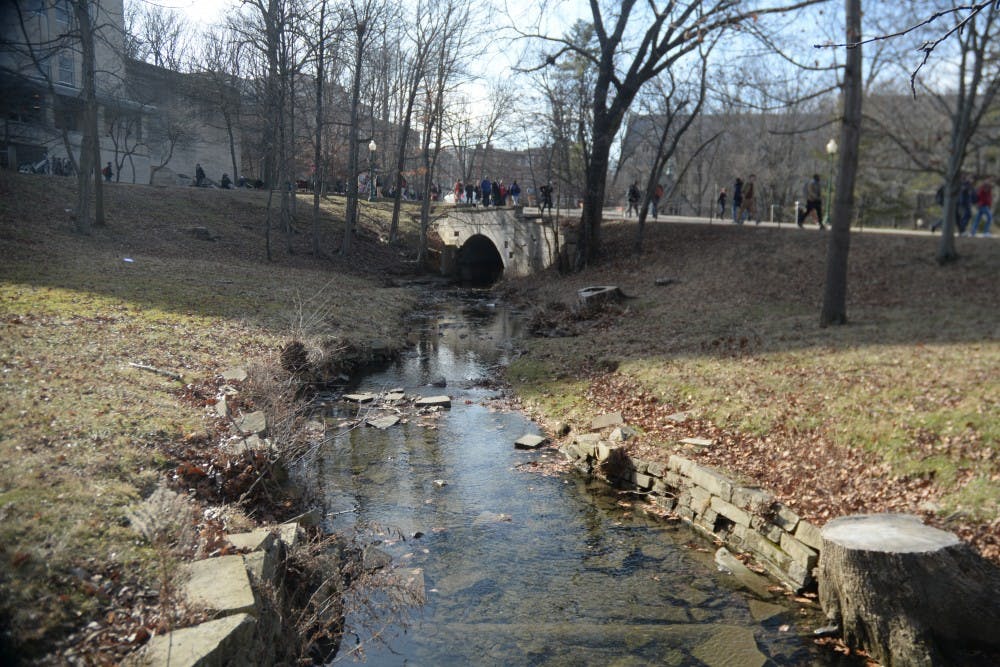Running through the core of IU's campus, the Jordan River is identified by IU’s 2010 Campus Master Plan as Bloomington’s most prominent natural feature.
Several IU professors capitalize on its convenient pathway and use the Jordan River as an educational tool for their classes.
The Jordan River is categorized as a natural stream, not a river. Its waters come from natural springs, surface runoff and storm drains. The main channel starts near Tulip Tree Apartments.
After flowing throughout campus, the stream goes through a culvert at Franklin Hall near the Sample Gates. It then connects to the City of Bloomington’s storm system and drains to the Clear Creek watershed.
According to IU’s Master Plan, 731 acres drain via the Jordan River to Clear Creek.
School of Public and Environmental Affairs Professor Christopher Craft uses the river to highlight the differences between natural and urban streams in his graduate level restoration ecology class, E534: Restoration Ecology.
The abundance of paved surfaces on IU’s campus cause the stream’s water flow to increase dramatically when it starts to rain.
“It's deeper, and it's faster, than if it was going through a forest,” Craft said.
Students used to kayak in the Jordan River near the Indiana Memorial Union during these floods, said Tyler Kivland, assistant program coordinator for IU Outdoor Adventures. This was easier when IU Outdoor Adventures, which provides gear rentals and offers classes in outdoor recreational activities, was located in the IMU. Now their gear shop is housed in Eigenmann Hall.
Kayaking in the stream is dangerous, as there are numerous hidden pipes and low bridges. Kivland said he hasn’t seen anyone attempt the feat in 10 years.
“It was not necessarily the safest decision,” Kivland said.
Kivland said he uses the Jordan River as a demonstration for whitewater rafting and whitewater canoeing courses.
Kivland and his students place miniature kayaks and canoes in the stream and observe what happens when they hit rocks and sticks. This teaches the students how to prepare for various conditions when they are in boats themselves.
“There really is no better way for us to teach river hydrology,” Kivland said.
The lack of vegetation along the Jordan River causes streambank erosion, Craft said. Its proximity to parking lots and the University’s fertilizers result in water quality issues as well.
“If you went out to a natural forest with a same size stream, you wouldn't have all these sorts of problems,” Craft said.
As part of his restoration ecology class, Craft assigns his students an exercise to identify what’s wrong with the stream and write a report on how to restore it.
The Jordan River is protected under the Clean Water Act, which requires federal supervision over its water quality.
IU's Master Plan recognizes that much of the river is in poor condition, and calls for restoring the river and its ecology.
Craft said when IU built a parking lot near Eigenmann Hall above the Jordan River, enclosing the stream in a culvert there, federal regulations ordered the University to do nearby restoration to offset the environmental damage.
Craft said university architects planted woody vegetation near the Jordan parking lot near Read Hall, and wetland plants in front of the Education Building to increase biodiversity and prevent invasive species.
In E440: Wetlands Ecology and Management, Craft and his students use the stream to identify various wetland plants and issue reports on the stream's health.
Craft has taken yearly pictures of the stream near the Wright Education Building to document the planting and progress towards restoration.
"If you let it go, especially in urban environments, you get a lot of invasive species," Craft said. "You can't just spend money, do they work, and then leave it."



![Dean_Reingold_ltr[52] (1).jpg](https://snworksceo.imgix.net/ids/25483b05-dabd-4378-92bd-70a32c2579f0.sized-1000x1000.jpg?w=1500&ar=16%3A9&fit=crop&crop=faces&facepad=3&auto=format)
